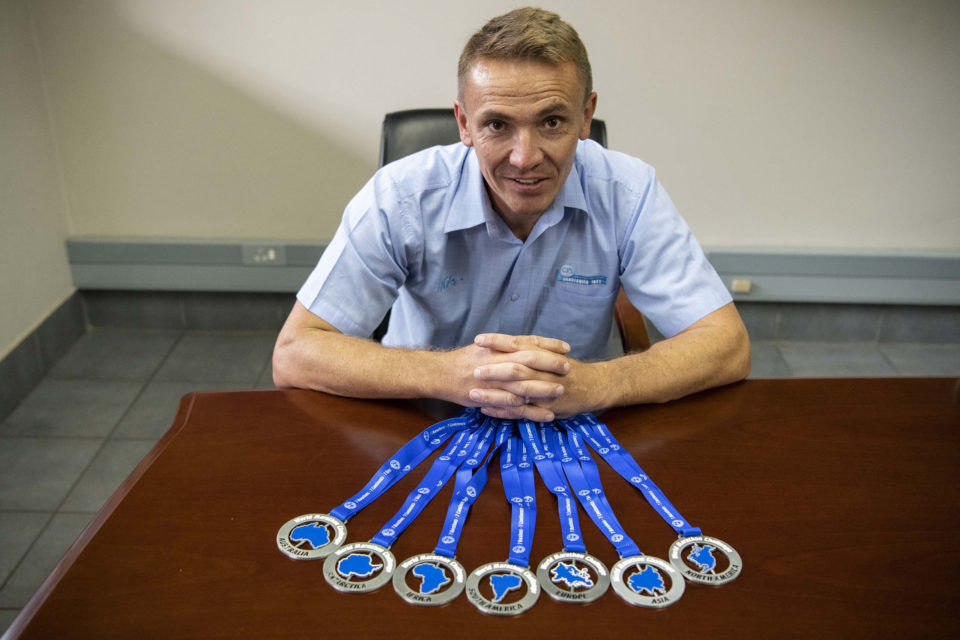South Africa’s World Marathon Challenge pioneer
What do you do when looking for adventure? If you’re Ross Taggart, you run seven marathons on seven continents in seven days.
Author:
5 March 2019

Seven marathons on seven continents in seven days. Sounds crazy, does it not?
Actually, impossible is perhaps the word many would utter on hearing that first line. But not when your name is Ross Taggart. The 47-year-old Johannesburg businessman recently achieved this seemingly improbable feat – and lived to tell the tale.
We meet in February, just two days after his return from this adventure. Aside from his medals, nothing about him tells the tale of this incredible feat. Unlike the thousands of runners who resemble penguins on the beaches of Durban the day after the Comrades Marathon, Taggart walks normally.
Related article:
Almost everything about him is normal. Except, that is, for the fact that he isn’t actually a runner. On hearing about his achievement, I had expectations of meeting up with a multi-Comrades finisher with an impressive personal best marathon time.
“I am not much of a runner,” he stuns me with as we settle in his office to talk. “I have never done Comrades and I hardly ever run marathons. The best I have done is the Tough One.” This is a 32km race run in Randburg, Johannesburg.
How, then, did he complete the World Marathon Challenge?
“I love adventures. I enjoy doing events that are not ordinary. I have done Lesotho Sky Run as well as the Marathon des Sables in Morocco for my 40th and 45th birthdays, and, having finished that, I started looking for some of the best and difficult races around the world.”
Toughest foot race on Earth
The Marathon des Sables is a 251km, six-day run (walk/crawl) through the Sahara Desert. It is generally referred to as the toughest foot race on earth. Taggart would have done the World Marathon Challenge last year, but an injury put paid to his dreams.
“I was fully registered for it, but I broke my leg and the organisers told me that there was no way they would refund me the little over half a million I had paid to participate. I was gutted and I think they could tell, and they said to me they would try to have me participate the following year should there be a space,” says Taggart.
“But when they did not call me by the end of last year, I gave up. And then, on 2 January, they called me to say there is a space open.”
Having not done any intensive training, Taggart could easily have given the race a pass. But a friend advised him not to try and cram in a lot of training lest he get injured again, and rather just go out to have fun.
And, boy, did he have a ball.
Related article:
“It was an amazing experience. And it took a lot of painkillers to get through it,” he laughs. “I really enjoyed it. There aren’t a lot of different challenges or niche events out there that one can do and to have done this one was really fulfilling. What made it awesome was the fact that the event was fantastically run. It was an absolute pleasure.”
A pleasure running 42.2km every day for seven days in a row? Many a runner would disagree.
“Who could say they ran in Antarctica? It was our first stop and they set up a course of about 5km on the ice that we had to do laps on until we completed the marathon distance.”
From race to the plane
The group of runners, Taggart explains, lived between the race and the chartered plane that was their home for the duration of the challenge.
“There was no staying in hotels because after each race we had to fly to the next one. But the plane was very comfortable and some of the experienced and competitive guys had these tubes that they got into after the runs to get their body to recover quickly for the next races.”
Of the seven continents, Taggart says he enjoyed Australia the most.
“After running on a slushy airstrip in the cold of Antarctica and then coming home to run Cape Town, we went to Perth. We arrived there at about midnight and the South West Athletic Club was there waiting for us. They marshalled the race on the riverside and even seconded us. Afterwards, they had a braai for us. It was a great experience.”
Related article:
Europe, where they ran in Madrid, was Taggart’s most difficult marathon.
“We ran at night. It was windy and freezing cold. We ran 13 laps between two mine shafts. I had on compressor pants and I really struggled. I went into that race having rolled my foot in Perth, so it was hard. It was the Chinese New Year and there were people celebrating and there was this lady who kept shouting, ‘Animal, Animal.’ It was hilarious.”
The South America race took place in Santiago, Chile, between two parks, and the last leg of the race was in Miami, Florida, in the United States.
“The Miami one was great because we had a lot of time in the bag, and also the weather was perfect, no winds and it was not too hot, and we ran on a flat and fast course.”
While there were some professionals competing, Taggart’s main aim was to just complete the race.
“There was no cut-off time. The slowest guy was a 76-year-old, but he always finished. The problem with running for a long time was that you had less time to rest before the next one. I always felt rested before the next race, though.”
‘One foot in front of the other’
Despite his modesty, Taggart’s times were impressive. Antarctica: 5:58:53, Africa (Cape Town): 5:21:08, Australia (Perth): 4:42:12, Asia (Dubai): 4:57:21, Europe (Madrid): 5:54:13, South America (Santiago): 6:14:01 and North America (Miami): 4:35:32.
Taggart finished 18th overall out of 24 competitors in the men’s section, with an average time of 5:23:20. But as he says, this was not about beating the clock, or even the other competitors.
“For me, this was all about trying new things and doing something to the end. I normally finish things. If I say I will do something, I do it. With this challenge, I always said to myself, ‘Put one foot in front of the other and some five hours or so later you will be finished.’ And that’s how I got through it. I remembered my karate days, I started at white belt and some five years later I was a black belt.”
The World Marathon Challenge now has Taggart as a South African pioneer of sorts.
“If there are any South Africans out there looking for a different challenge, I would definitely recommend this one. It is a very well organised event.”
Next up for Taggart is a run in Rome.



